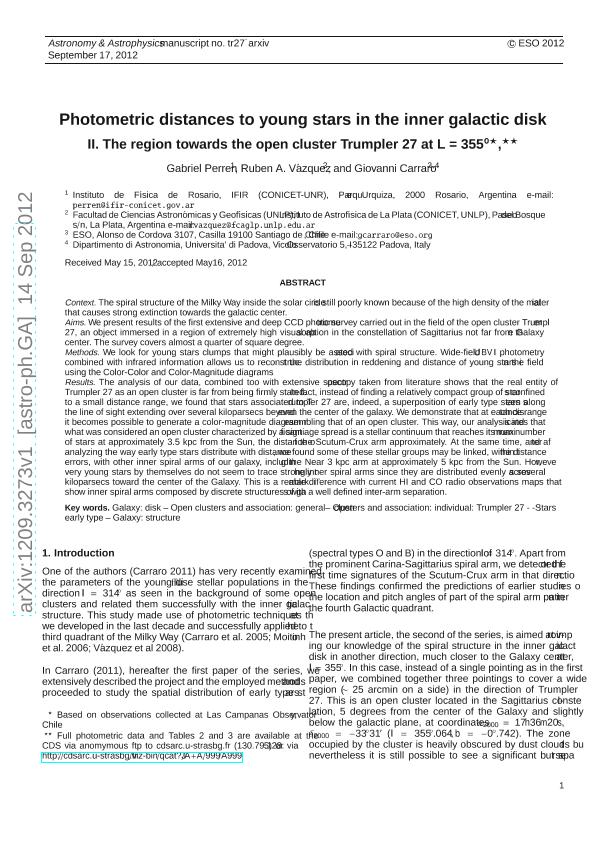Mostrar el registro sencillo del ítem
dc.contributor.author
Perren, Gabriel Ignacio

dc.contributor.author
Vazquez, Ruben Angel

dc.contributor.author
Carraro, Giovanni

dc.date.available
2018-04-19T13:02:13Z
dc.date.issued
2012-12
dc.identifier.citation
Perren, Gabriel Ignacio; Vazquez, Ruben Angel; Carraro, Giovanni; Photometric distances to young stars in the inner Galactic disk. II. The region towards the open cluster Trumpler 27 at L = 355°; EDP Sciences; Astronomy and Astrophysics; 12-2012; 1-14
dc.identifier.issn
0004-6361
dc.identifier.uri
http://hdl.handle.net/11336/42594
dc.description.abstract
Context. The spiral structure of the Milky Way inside the solar circle is still poorly known because of the high density of the material that causes strong extinction towards the Context. The spiral structure of the Milky Way inside the solar circle is still poorly known because of the high density of the material that causes strong extinction towards the Galactic center. Aims. We present results of the first extensive and deep color–color diagram (CCD) photometric survey carried out in the field of the open cluster Trumpler 27, an object immersed in a region of extremely high visual absorption in the constellation of Sagittarius not far from the Galaxy center. The survey covers almost a quarter of square degree. Methods. We look for young stars clumps that might plausibly be associated with spiral structure. Wide-field UBVI photometry combined with infrared information allows us to reconstruct the distribution in the reddening and distance of young stars in the field using the CCD and color–magnitude diagrams (CMD). Results. The analysis of our data, combined with extensive spectroscopy taken from the literature, shows that the real entity of Trumpler 27 as an open cluster is far from being firmly stated. In fact, instead of finding a relatively compact group of stars confined to a small distance range, we found that stars associated with Trumpler 27 are, indeed, a superposition of early-type stars seen along the line of sight extending over several kiloparsecs beyond even the center of the Galaxy. We demonstrate that at each distance range it becomes possible to generate a CMD resembling that of an open cluster. This way, our analysis indicates that what was considered an open cluster characterized by a significant age spread is a stellar continuum that reaches its maximum number of stars at approximately 3.5 kpc from the Sun, the distance of the Scutum-Crux arm approximately. After analyzing the way early-type stars distribute with distance, we found that some of these stellar groups may be linked, within the distance errors, with other inner spiral arms of our Galaxy, including the Near 3 kpc arm at approximately 5 kpc from the Sun. However, very young stars by themselves do not seem to trace strongly the inner spiral arms since they are distributed evenly across several kiloparsecs toward the center of the Galaxy. This is remarkably different to current HI and CO radio observation maps, which show inner spiral arms composed by discrete structures of gas with a well-defined inter-arm separation.
dc.format
application/pdf
dc.language.iso
eng
dc.publisher
EDP Sciences

dc.rights
info:eu-repo/semantics/openAccess
dc.rights.uri
https://creativecommons.org/licenses/by-nc-sa/2.5/ar/
dc.subject
Galaxy
dc.subject
Galactic Disks
dc.subject
Open Clusters
dc.subject
Milky Way
dc.subject
Trumpler 27 (Galaxia)
dc.subject
Early Type Stars
dc.subject.classification
Astronomía

dc.subject.classification
Ciencias Físicas

dc.subject.classification
CIENCIAS NATURALES Y EXACTAS

dc.title
Photometric distances to young stars in the inner Galactic disk. II. The region towards the open cluster Trumpler 27 at L = 355°
dc.type
info:eu-repo/semantics/article
dc.type
info:ar-repo/semantics/artículo
dc.type
info:eu-repo/semantics/publishedVersion
dc.date.updated
2018-04-16T14:55:31Z
dc.journal.pagination
1-14
dc.journal.pais
Francia

dc.journal.ciudad
Paris
dc.description.fil
Fil: Perren, Gabriel Ignacio. Consejo Nacional de Investigaciones Científicas y Técnicas. Centro Científico Tecnológico Conicet - Rosario. Instituto de Física de Rosario. Universidad Nacional de Rosario. Instituto de Física de Rosario; Argentina
dc.description.fil
Fil: Vazquez, Ruben Angel. Consejo Nacional de Investigaciones Científicas y Técnicas. Centro Científico Tecnológico Conicet - La Plata. Instituto de Astrofísica La Plata. Universidad Nacional de La Plata. Facultad de Ciencias Astronómicas y Geofísicas. Instituto de Astrofísica La Plata; Argentina. Universidad Nacional de La Plata. Facultad de Ciencias Astronómicas y Geofísicas; Argentina
dc.description.fil
Fil: Carraro, Giovanni. Università di Padova; Italia
dc.journal.title
Astronomy and Astrophysics

dc.relation.alternativeid
info:eu-repo/semantics/altIdentifier/doi/http://dx.doi.org/10.1051/0004-6361/201219653
dc.relation.alternativeid
info:eu-repo/semantics/altIdentifier/url/https://www.aanda.org/articles/aa/abs/2012/12/aa19653-12/aa19653-12.html
Archivos asociados
